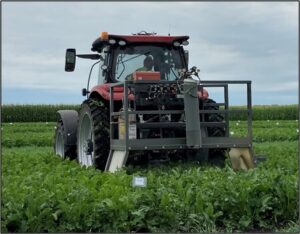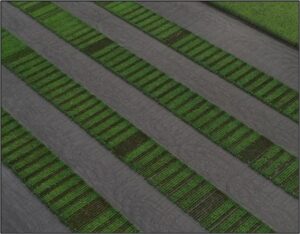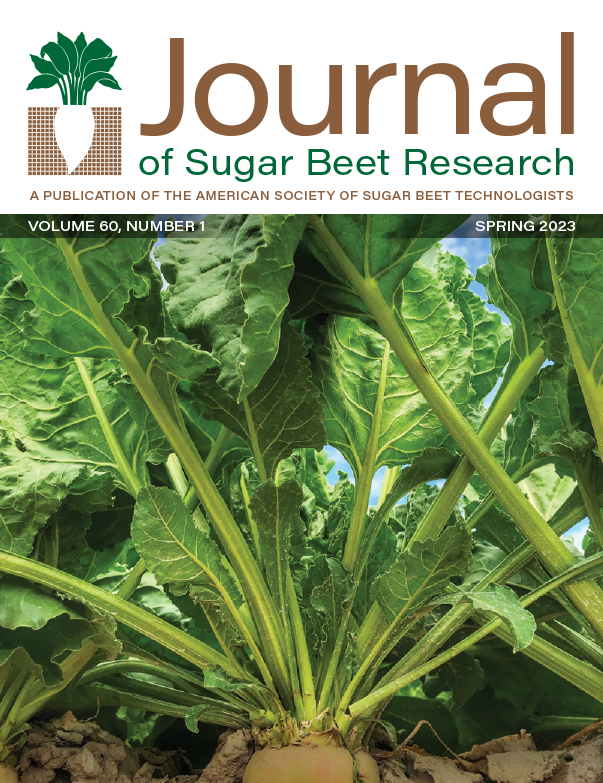Research Objective
- Evaluate new Cercospora leaf spot (CLS) tolerant sugar beet varieties to determine the appropriate fungicide spray program.
Methodology
Four similar trials were conducted as randomized complete block with four replications at two sites in 2020 and two sites in 2021. In both years, one site was located near Clara City, MN and the other was located near Hector, MN. These trials evaluated three varieties with differing levels of genetic tolerance to CLS (2.0, 3.0, and 4.0 on the Kleinwanzlebener Saatzucht [KWS] rating scale) across six fungicide programs for a total of 18 treatments per location. The variety ratings were based on data from the SMBSC Official Variety Trial CLS nursery. Standard production practices were used to keep the sites free from weeds and other diseases. The sites were inoculated with pulverized leaves from the previous year that were infected with CLS (fungicide sensitivity unknown). The inoculum was spread evenly across each site with a Gandy Orbit-Air applicator. Each plot consisted of six rows that were 35 feet in length. Fungicide treatments were applied to the center four rows using a custom-made tractor mounted hooded sprayer utilizing CO2 as a propellant (Photo 1). Rows one and six were left untreated as visual checks between plots (Photo 2).
The fungicide treatments were applied with a spray volume of 20 gpa and 60 psi, utilizing XR11002 nozzles. The same deposition aid adjuvant was included in all treatment applications. Fungicide applications were made on a ten-to-twelve-day interval beginning after inoculation. Letters following the fungicide program description indicate the timing of the fungicide applications (Tables 2, 3, 4, and 5). Foliar disease ratings were made using the KWS (1-9) rating scale with 1 having very little disease and 9 having a high level of disease severity. Foliar ratings were taken by members of the SMBSC research staff every two weeks after visual symptoms appeared in the check plots.

Photo 1. Tractor mounted hooded sprayer used to apply fungicide treatments.

Photo 2. Drone image of 2020 Clara City site.
The foliar ratings presented in this report are the average of all raters with only the final date of ratings presented (Table 1). The center two rows of each six-row plot were harvested. The beets harvested from the center two rows were weighed on the harvester and a sample of those beets were used for quality analysis at the SMBSC tare lab. Only the extractable sugar per acre (ESA) data is presented in this report. The trials at the four sites were not identical so the data was not combined and thus is presented separately (Tables 2, 3, 4, and 5). The yield data was analyzed using SAS 9.4 Proc GLM and disease foliar rating data was analyzed using SAS 9.4 Proc Anova.
Table 1. Important dates for each of the four locations.
| Location | Planting Date | Inoculation Date | First Fungicide Application | Final Foliar Rating Date | Harvest Date |
| Clara City 2020 | April 27th | July 6th | July 9th | September 14th | September 25th |
| Hector 2020 | May 5th | July 10th | July 16th | October 1st | October 9th |
| Clara City 2021 | April 24th | June 28th | June 30th | September 15th | September 23rd |
| Hector 2021 | April 29th | July 8th | July 12th | September 8th | September 10th |
Results
In every location, the moderate variety (KWS = 3) had very similar results to the traditional variety (KWS = 4). As such, the data from the moderate variety (KWS = 3, treatments 7 – 12) is not presented in this report. To keep this report concise only the data from the final foliar rating and extractable sugar per acre (ESA) are shown and discussed (Tables 2, 3, 4, and 5). Other data may be made available upon request.
The only treatment for the traditional variety (KWS = 4) that provided an acceptable level of disease control at every site was the standard six spray tank-mixed program. All other treatments for the traditional variety did not provide adequate control except for treatment 17 in the 2020 Clara City trial. That treatment consisted of six applications of an EBDC product without any tank-mix partners. This provided similar control to the standard tank-mix program, which may have been due to the limited rainfall that occurred at that site. This may have allowed the EBDC to provide protection from infection for a longer period of time since in normal conditions it is prone to washing off the leaves in moderate rainfall events.
The check for the tolerant variety (KWS = 2) still developed disease to the point of causing a significant yield loss in two of the trials. In every trial, the untreated check had a higher level of disease pressure than all other treatments with the tolerant variety. All the tolerant variety fungicide programs had better disease control than the standard six spray tank-mix program for the traditional variety. As the number of applications was reduced the disease severity generally increased. The disease severity also increased as the initiation date of the fungicide program was delayed or if a single mode of action was used instead of a tank-mixed application.
Conclusions
It was no surprise that the standard tank-mix fungicide program was the best treatment for the traditional variety. Unfortunately, even the standard six spray tank-mix fungicide program sometimes is not good enough to keep commercial fields at an acceptable level of CLS. The new tolerant varieties are seen as a way to reduce the reliance on fungicides to control CLS. However, our research indicates that these new tolerant varieties are not immune to the disease and do require a fungicide program to maintain adequate control. The great news is that the fungicide program required for these tolerant varieties is perhaps half of the fungicide applications required for the traditional varieties. In the event of poor weather conditions for making spray applications, the new tolerant varieties should provide growers with more flexibility to make applications without falling behind on controlling the disease. However, it appears that an early start and tank mixing different modes of action are still important management practices in controlling CLS and keeping this genetic tool viable for long term use.
Table 2. 2020 Clara City CLS rating and yield data.
| Treatment # | Variety* | Fungicide Program | KWS CLS Rating
(1-9) |
Extractable Sugar per Acre (lbs) |
| 1 | 2 | Check | 6.7 d | 8,140.5 efg |
| 2 | 2 | 3 Spray Tank-Mix Program (ACE) | 2.0 j | 10,373.5 ab |
| 3 | 2 | 6 Spray Tank-Mix Program (ABCDEF) | 1.7 j | 11,007.5 a |
| 4 | 2 | 3 Spray No Tank-Mix (ACE) | 2.9 i | 9,842.8 bcd |
| 5 | 2 | 6 Spray No Tank-Mix (ABCDEF) | 2.0 j | 9,378.0 cd |
| 6 | 2 | 3 Spray No Tank-Mix (CDE) | 4.0 h | 9,872.0 bc |
| 13 | 4 | Check | 9.0 a | 6,493.8 ij |
| 14 | 4 | 3 Spray Tank-Mix Program (ACE) | 7.1 cd | 9,879.5 bc |
| 15 | 4 | 6 Spray Tank-Mix Program (ABCDEF) | 6.1 e | 9,881.5 bc |
| 16 | 4 | 3 Spray No Tank-Mix (ACE) | 8.3 b | 8,221.5 ef |
| 17 | 4 | 6 Spray No Tank-Mix (ABCDEF) | 6.6 de | 9,712.0 bcd |
| 18 | 4 | 3 Spray No Tank-Mix (CDE) | 9.0 a | 7,171.3 hi |
| Mean | 5.7 | 8,759.4 | ||
| CV% | 6.6 | 7.7 | ||
| Pr>F | <.0001 | <.0001 | ||
| lsd (0.05) | 0.53 | 951.0 |
*Variety 2 = new tolerant CLS variety (KWS = 2), Variety 4 = traditional variety (KWS = 4)
Table 3. 2020 Hector CLS rating and yield data.
| Treatment # | Variety* | Fungicide Program | KWS CLS Rating
(1-9) |
Extractable Sugar per Acre (lbs) |
| 1 | 2 | Check | 4.6 h | 6,557.0 bc |
| 2 | 2 | 6 Spray Program (ABCDEF) | 2.1 k | 6,831.3 ab |
| 3 | 2 | 2 Spray Program (AC) | 2.7 j | 6,877.8 ab |
| 4 | 2 | 3 Spray Program (ABC) | 2.4 jk | 7,343.5 a |
| 5 | 2 | 3 Spray Program (CDE) | 1.5 l | 7,113.3 ab |
| 6 | 2 | 2 Spray Program (CE) | 2.7 j | 6,881.8 ab |
| 13 | 4 | Check | 9.0 a | 4,302.5 g |
| 14 | 4 | 6 Spray Program (ABCDEF) | 6.2 f | 6,529.8 bc |
| 15 | 4 | 2 Spray Program (AC) | 8.5 ab | 5,891.3 cde |
| 16 | 4 | 3 Spray Program (ABC) | 7.7 cd | 5,931.8 cd |
| 17 | 4 | 3 Spray Program (CDE) | 7.3 de | 5,980.3 cd |
| 18 | 4 | 2 Spray Program (CE) | 8.7 a | 5,684.5 de |
| Mean | 5.6 | 6,067.9 | ||
| CV% | 6.6 | 7.9 | ||
| Pr>F | <.0001 | <.0001 | ||
| lsd (0.05) | 0.53 | 681.6 |
*Variety 2 = new tolerant CLS variety (KWS = 2), Variety 4 = traditional variety (KWS = 4)
Table 4. 2021 Clara City CLS rating and yield data.
| Treatment # | Variety* | Fungicide Program | KWS CLS Rating
(1-9) |
Extractable Sugar per Acre (lbs) |
| 1 | 2 | Check | 6.8 e | 9,026.1 c |
| 2 | 2 | 6 Spray Program (ABCDEF) | 1.2 j | 10,891.4 ab |
| 3 | 2 | 2 Spray Program (AC) | 3.1 gh | 11,230.6 a |
| 4 | 2 | 3 Spray Program (ABC) | 2.4 i | 11,345.9 a |
| 5 | 2 | 3 Spray Program (CDE) | 2.9 hi | 10,758.8 ab |
| 6 | 2 | 2 Spray Program (CE) | 3.9 f | 10,646.8 ab |
| 13 | 4 | Check | 9.0 a | 5,967.0 g |
| 14 | 4 | 6 Spray Program (ABCDEF) | 3.6 fg | 10,822.6 ab |
| 15 | 4 | 2 Spray Program (AC) | 9.0 a | 9,003.1 c |
| 16 | 4 | 3 Spray Program (ABC) | 7.8 d | 10,174.4 b |
| 17 | 4 | 3 Spray Program (CDE) | 7.7 d | 8,413.0 cde |
| 18 | 4 | 2 Spray Program (CE) | 8.5 bc | 7,643.3 ef |
| Mean | 6.1 | 9,032.9 | ||
| CV% | 5.5 | 7.9 | ||
| Pr>F | <.0001 | <.0001 | ||
| lsd (0.05) | 0.47 | 1,011.7 |
*Variety 2 = new tolerant CLS variety (KWS = 2), Variety 4 = traditional variety (KWS = 4)
Table 5. 2021 Hector CLS rating and yield data.
| Treatment # | Variety* | Fungicide Program | KWS CLS Rating
(1-9) |
Extractable Sugar per Acre (lbs) |
| 1 | 2 | Check | 5.5 e | 7,734.8 abc |
| 2 | 2 | 5 Spray Program (0ABCDE) | 1.5 k | 7,724.6 abcd |
| 3 | 2 | 3 Spray Tin Program (0ACE) | 2.2 ij | 7,455.5 bcde |
| 4 | 2 | 3 Spray Triazole Program (0ACE) | 2.5 i | 7,125.2 de |
| 5 | 2 | 2 Spray Triazole Program (BD) | 3.5 gh | 7,778.5 ab |
| 6 | 2 | EBDC Alone Program (0ABCDE) | 1.9 jk | 7,646.7 bcd |
| 13 | 4 | Check | 9.0 a | 5,736.7 hi |
| 14 | 4 | 5 Spray Program (0ABCDE) | 3.6 g | 7,780.6 ab |
| 15 | 4 | 3 Spray Tin Program (0ACE) | 6.4 cd | 7,291.4 bcde |
| 16 | 4 | 3 Spray Triazole Program (0ACE) | 6.5 c | 7,452.8 bcde |
| 17 | 4 | 2 Spray Triazole Program (BD) | 8.5 b | 6,439.0 fg |
| 18 | 4 | EBDC Alone Program (0ABCDE) | 5.3 ef | 8,302.5 a |
| Mean | 5.2 | 7,119.0 | ||
| CV% | 6.4 | 6.0 | ||
| Pr>F | <.0001 | <.0001 | ||
| lsd (0.05) | 0.47 | 606.1 |
*Variety 2 = new tolerant CLS Variety (KWS = 2), variety 4 = traditional variety (KWS = 4)

